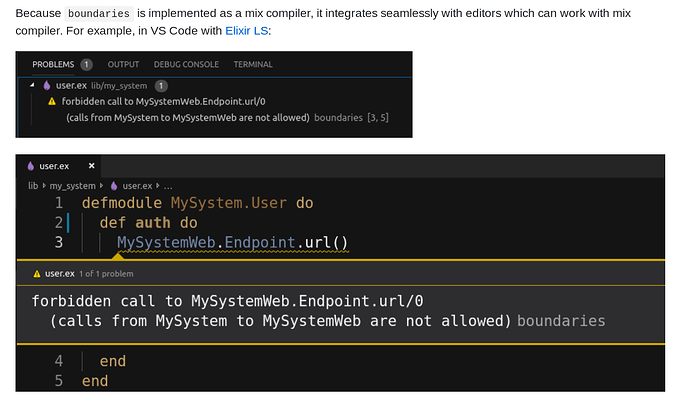Great questions, thanks!
TBH I didn’t. This simple exs was a first thing that came to mind 
But now that you mention it, if we think about larger projects where developers want to be fine grained and so create a larger number of boundaries, I think that a decentralized approach would definitely scale better than a single .exs file which would possibly become bloated.
I guess a big unknown for me at this point is do we expect such fine granularity? I’d typically expect a much smaller amount of boundaries compared to the number of modules. And if I’m right, then perhaps a centralized solution might be simpler.
OTOH, I do have some ideas to support sub-boundaries (internal boundaries within boundaries), and for that approach, I think that decentralized definitely seems like a better option.
Another win for decentralized is that you don’t need to sync another file. So for example, if you delete or rename a module, the boundary info is auto updated.
One small issue with decentralized is that a root module always has to exist. So if I don’t have a root module, I need to create it for the sole purpose of having a boundary. Perhaps that’s fine.
Also, the usage would then probably look like:
defmodule MyBoundary do
use Boundary,
exports: [...],
deps: [...]
end
Which, under the hood would be persisted to BEAM, so they can be collected by the boundaries checker.
I’m a bit unhappy about using use, but ATM I don’t see a simple solution which isn’t built on use.
No, but that’s an interesting idea, thanks! I’ll keep it in mind.
Absolutely agree! I advertise it as an alternative to umbrella for specifying and enforcing boundaries. Nothing more than that 
In theory, it already works (compiler is marked as recursive). In practice, I have no idea because I haven’t tested it  If boundaries in umbrella projects don’t work, open up an issue on the repo.
If boundaries in umbrella projects don’t work, open up an issue on the repo.
Currently no, but you make good argument why this might make sense.

 Your readme is great. I was just explaining how
Your readme is great. I was just explaining how 




















